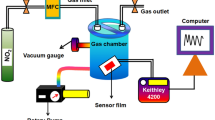Abstract
In this paper, polyethyleneimine (PEI) and reduced graphene oxide (RGO) were selected as sensing materials for carbon dioxide detection. Two kinds of sensors with different sensitive film structures, i.e., RGO–PEI composite film and RGO–PEI bi-layer film were fabricated by airbrushing the sensitive films on interdigitated electrodes. Response performances of both sensors at room temperature were investigated. Results showed that sensors with bi-layer film exhibited smaller baseline drift and more stable sensing characteristics than the counterparts with composite film. Furthermore, bi-layer film sensors with different quantity of PEI solution deposited were studied. Performances of long-time stability, repeatability, low concentration of detection for carbon dioxide, and measurements of response time and recovery time were investigated. It was found that appropriate weight ratio of RGO and PEI was critical for sensing response. In addition, the sensor with bi-layer film exhibited a better repeatability but had longer response time and recovery time than RGO single-layer sensor, and both of them could detect as low as 20 parts per million carbon dioxide gas. Sensing responses of the prepared sensors to carbon dioxide under dry air or nitrogen were compared. The relevant sensing mechanisms were studied as well.











Similar content being viewed by others
References
Eisenberger PM, Cohen RW, Chichilnisky G et al (2009) Global warming and carbon-negative technology: prospects for a lower-cost route to a lower-risk atmosphere. Energy Environ Sci 20:973–984
Imanaka N, Murata T, Kawasato T et al (1993) CO2 detection with lithium solid electrolyte sensors. Sens Actuators B 13:476–479
Lee C, Akbar SA, Park CO (2001) Potentiometric CO2 gas sensor with lithium phosphorous oxynitride electrolyte. Sens Actuators B 80:234–242
Ishihara T, Kometani K, Mizuhara Y et al (1991) A new type of CO2 gas sensor based on capacitance changes. Sens Actuators B 5:97–102
Kuze A, Suto H, Nakajima M et al (2009) Thermal and near infrared sensor for carbon observation Fourier-transform spectrometer on the Greenhouse Gases Observing Satellite for greenhouse gases monitoring. Appl Opt 48:6716–6733
Hwang HR, Roh JG, Lee DD et al (2003) Sensing behavior of the polypyrrole and polyaniline sensor for several volatile organic compounds. Met Mater Int 9:287–291
Xie G, Sun P, Yan X et al (2010) Fabrication of methane gas sensor by layer-by-layer self-assembly of polyaniline/PdOultra thin films on quartz crystal microbalance. Sens Actuators B 145:373–377
Neethirajan S, Jayas DS, Sadistap S (2009) Carbon dioxide sensors for the agri-food industry-a review. Food Bioprocess Technol 2:115–121
Schedin F, Geim AK, Morozov SV et al (2007) Detection of individual gas molecules adsorbed on graphene. Nat Mater 6:652–655
Serban B, SarinKumar AK, Costea S et al (2009) Polymer-amino carbon nanotube nanocomposites for surface acoustic wave CO2 detection. Rom J Inf Sci Technol 12:376–384
Li X, Cai W, An J et al (2009) Large-area synthesis of high-quality and uniform graphene films on copper foils. Science 324:1312–1314
Reina A, Jia X, Ho J et al (2009) Large area, few-layer graphene films on arbitrary substrates by chemical vapor deposition. Nano Lett 9:30–35
Dan Y, Lu Y, Kybert NJ et al (2009) Intrinsic response of graphene vapor sensors. Nano Lett 9:1472–1475
Dua V, Surwade SP, Ammu S et al (2010) All organic vapor sensor using inkjet printed reduced graphene oxide. Angew Chem Int Ed 49:2154–2157
Yoon HJ, Jun DH, Yang JH et al (2011) Carbon dioxide gas sensor using a graphene sheet. Sens Actuators B 157:310–313
Wu W, Liu Z, Jauregui LA et al (2010) Wafer-scale synthesis of graphene by chemical vapor deposition and its application in hydrogen sensing. Sens Actuators B 150:296–300
Al-Mashat L, Shin K, Kalantar-zadeh K et al (2010) Graphene/polyaniline nanocomposite for hydrogen sensing. J Phys Chem C 114:16168–16173
Lu G, Park S, Yu K et al (2011) Toward practical gas sensing with highly reduced graphene oxide: a new signal processing method to circumvent run-to-run and device-to-device variations. ACS Nano 5:1154–1164
Lu G, Ocola LE, Chen J (2009) Reduced graphene oxide for room-temperature gas sensors. Nanotechnology 20:1–9
Collins PG, Bradley K, Ishigami M et al (2000) Extreme oxygen sensitivity of electronic properties of carbon nanotubes. Science 287:1801–1804
Fowler JD, Allen MJ, Tung VC et al (2009) Practical chemical sensors from chemically derived graphene. ACS Nano 3:301–306
Li J, Lu Y, Ye Q et al (2003) Carbon nanotube sensors for gas and organic vapor detection. Nano Lett 3:929–933
Serban B, Kumar AKS, Brezeanu M et al (2011) Amino groups-based polymers for CO2 detection; A comparison between two sensing mechanism models. Paper presented at Semiconductor Conference (CAS), 2011 International, Sinaia, 17–19 October 2011
Moon IK, Lee J, Ruoff RS et al (2010) Reduced graphene oxide by chemical graphitization. Nat Commun 1:73–79
Star A, Han TR, Joshi V et al (2004) Nanoelectronic carbon dioxide sensors. Adv Mater 16:2049–2052
Shim M, Javey A, Kam NWS et al (2001) Polymer functionalization for air-stable n-type carbon nanotube field-effect transistors. J Am Chem Soc 123:11512–11513
Xu JQ, Chen YP, Chen DY (2006) Hydrothermal synthesis and gas sensing characters of ZnO nanorods. Sens Actuators B113:526–531
Currie LA (1995) Nomenclature in evaluation of analytical methods including detection and quantification capabilities. Pure Appl Chem 67:1699
Acknowledgments
This work was partially supported by Specialized Research Fund for the Doctoral Program of Higher Education (20120185110012) and the National Natural Science Foundation of China (61176006, 61006036).
Author information
Authors and Affiliations
Corresponding author
About this article
Cite this article
Zhou, Y., Jiang, Y., Xie, G. et al. Gas sensors for CO2 detection based on RGO–PEI films at room temperature. Chin. Sci. Bull. 59, 1999–2005 (2014). https://doi.org/10.1007/s11434-014-0253-2
Received:
Accepted:
Published:
Issue Date:
DOI: https://doi.org/10.1007/s11434-014-0253-2




